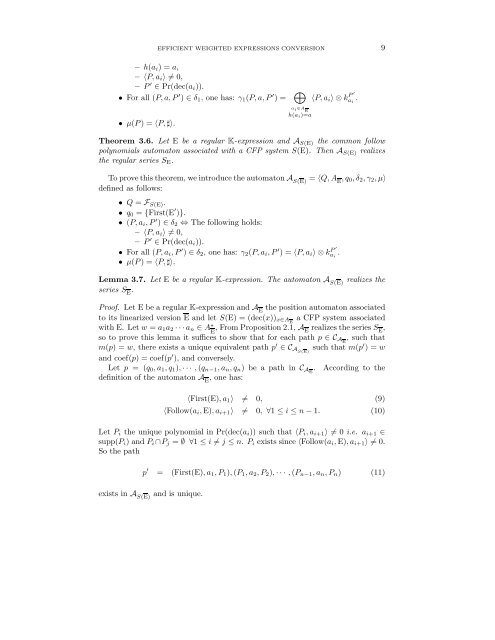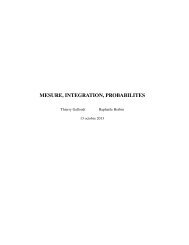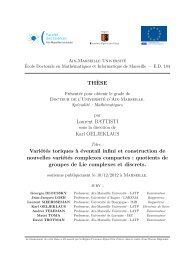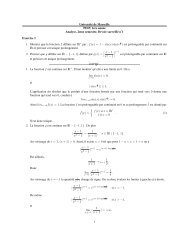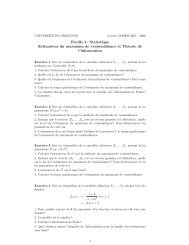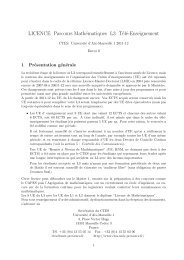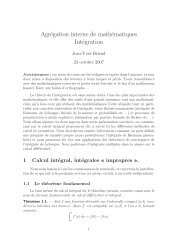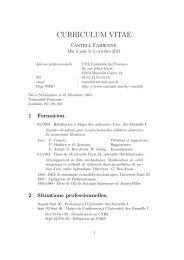Faissal Ouardi and Djelloul Ziadi Introduction - CMI
Faissal Ouardi and Djelloul Ziadi Introduction - CMI
Faissal Ouardi and Djelloul Ziadi Introduction - CMI
You also want an ePaper? Increase the reach of your titles
YUMPU automatically turns print PDFs into web optimized ePapers that Google loves.
EFFICIENT WEIGHTED EXPRESSIONS CONVERSION 9<br />
– h(ai) =a,<br />
– 〈P, ai〉 �= 0,<br />
– P ′ ∈ Pr(dec(ai)).<br />
• For all (P, a, P ′ ) ∈ δ1, one has: γ1(P, a, P ′ )= �<br />
• μ(P )=〈P, ♯〉.<br />
a i ∈A E<br />
h(ai)=a<br />
′<br />
P<br />
〈P, ai〉⊗kai .<br />
Theorem 3.6. Let E be a regular K-expression <strong>and</strong> A S(E) the common follow<br />
polynomials automaton associated with a CFP system S(E). Then A S(E) realizes<br />
the regular series SE.<br />
To prove this theorem, we introduce the automaton AS(E) = 〈Q, AE ,q0,δ2,γ2,μ〉<br />
defined as follows:<br />
• Q = FS(E). • q0 = {First(E ′ )}.<br />
• (P, ai,P ′ ) ∈ δ2 ⇔ The following holds:<br />
– 〈P, ai〉 �= 0,<br />
– P ′ ∈ Pr(dec(ai)).<br />
• For all (P, ai,P ′ ) ∈ δ2, one has: γ2(P, ai,P ′ ′<br />
P )=〈P, ai〉⊗k<br />
• μ(P )=〈P, ♯〉.<br />
Lemma 3.7. Let E be a regular K-expression. The automaton A S(E) realizes the<br />
series S E .<br />
Proof. Let E be a regular K-expression <strong>and</strong> A E the position automaton associated<br />
to its linearized version E<strong>and</strong>letS(E) = (dec(x))x∈A E a CFP system associated<br />
with E. Let w = a1a2 ···an ∈ A ∗<br />
E , From Proposition 2.1, A E realizes the series S E ,<br />
so to prove this lemma it suffices to show that for each path p ∈CA E , such that<br />
m(p) =w, there exists a unique equivalent path p ′ ∈CA S(E) such that m(p ′ )=w<br />
<strong>and</strong> coef(p) = coef(p ′ ), <strong>and</strong> conversely.<br />
Let p = (q0,a1,q1), ··· , (qn−1,an,qn) beapathinCA E . Accordingtothe<br />
definition of the automaton A E , one has:<br />
〈First(E),a1〉 �= 0, (9)<br />
〈Follow(ai, E),ai+1〉 �= 0, ∀1 ≤ i ≤ n − 1. (10)<br />
Let Pi the unique polynomial in Pr(dec(ai)) such that 〈Pi,ai+1〉 �= 0i.e. ai+1 ∈<br />
supp(Pi) <strong>and</strong>Pi ∩Pj = ∅ ∀1 ≤ i �= j ≤ n. Pi exists since 〈Follow(ai, E),ai+1〉 �= 0.<br />
So the path<br />
p ′ = (First(E),a1,P1), (P1,a2,P2), ··· , (Pn−1,an,Pn) (11)<br />
exists in A S(E) <strong>and</strong> is unique.<br />
ai .


